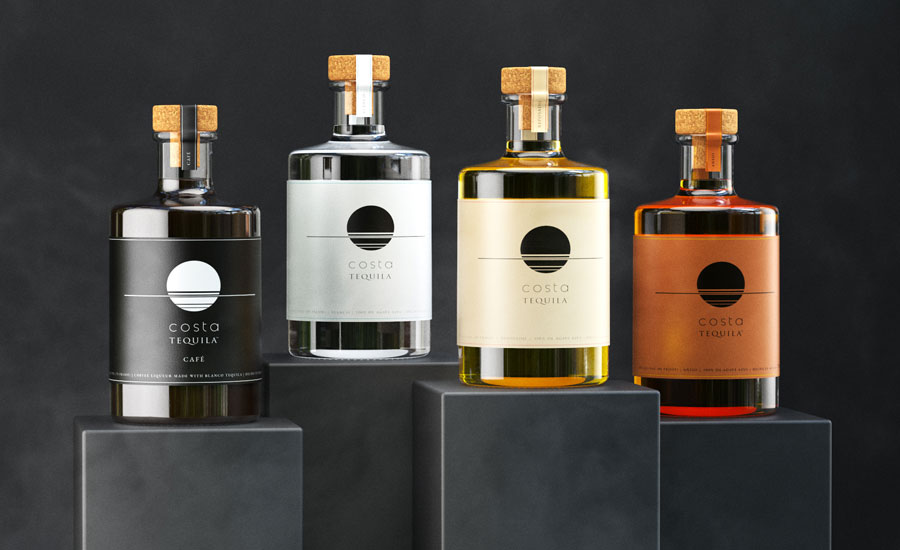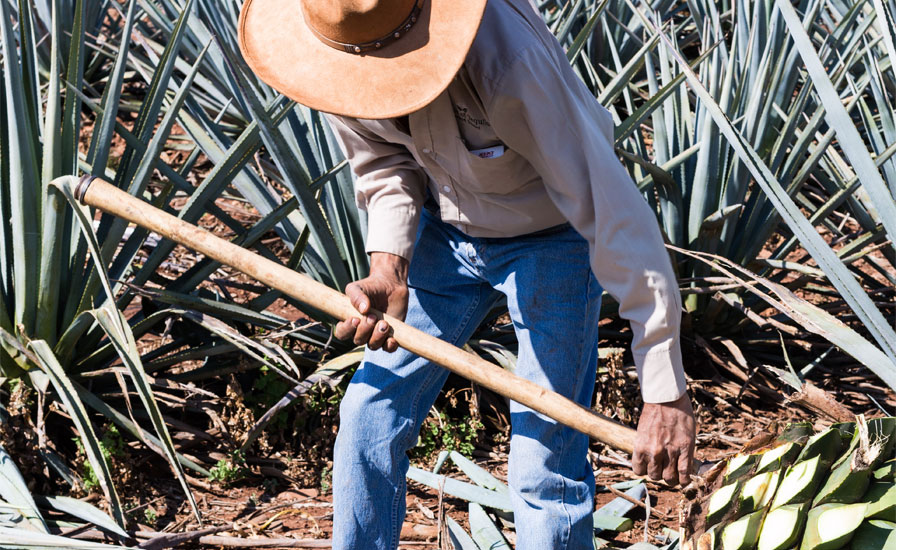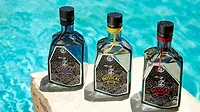Tequila, mezcal brands aim to please consumers with premium, authentic products
Knowledgeable consumers desire versatile spirits

Image courtesy of Pernod Ricard
In her 2019 song “Tequila Does,” country music star Miranda Lambert sings about how men cannot compete with tequila. “They don’t love me like tequila does, nobody can / They don’t give me that border town buzz like tequila does,” she sings in the chorus.
Although consumers are not always chasing a buzz or boys, they certainly are chasing after premium tequila and mezcal.
Stephan Gavula III, founder of Florida-based Costa Tequila, explains how premiumization trends have influenced the tequila and mezcal markets in the United States. He calls it a natural progression.
“As consumers venture into a new spirits category, they often hold the belief that the best quality products will be at the highest price point, driving producers to price higher for perceived quality,” Gavula says. “I can speak specifically to the tequila industry, where this trend has continued over the last five years. However, in 2023, this trend reversed course ― also a natural progression as categories mature.”
He notes he has found consumers more knowledgeable now about the spirit and trading down as they become more confident about their own ability to determine the quality of products in the premium and ultra-premium categories.

“Our goal at Costa Tequila, through our Hi/Lo concept, has been to educate customers on the attributes of tequila and the flavor profiles of agave, allowing them to choose a brand that best fits their taste and interest profiles,” Gavula adds.
Jim Green, chief operations officer at Dos Hombres, Encino, CA, feels that premiumization trends have “drastically increased” the sales of mezcal and tequila. He says a few factors are driving the increase, including the notion of consumers drinking less now than in the past and the search for healthier alternatives that are often at higher price points.
“At Dos Hombres, we always strive to educate consumers about the liquid and the process so they can appreciate the category and the flavor and understand the price point,” Green states. “Our mezcal is crafted with only two ingredients — Espadin agave and mountain spring water — and produced according to the same traditional and sustainable methods that our Mescalero has used for generations.”
Xavier Zamudio, senior brand manager at Tequila Avión, New York, shares that premiumization trends have provided both opportunities and challenges for tequila and mezcal brands. As consumers have evolved in their appreciation for higher-quality tequila, he says there has been a greater demand for refined expressions.
“This shift has prompted producers to deliver superior products, capitalizing on consumers’ growing discernment of the benefits and nuanced flavors associated with premium tequila,” he states. “This surge in premiumization has not only elevated the overall quality, but also sparked innovation and experimentation. Producers are exploring new horizons in aging, barrel selection, finishes, ancestral methods and infustions.”
Zamudio considers the market to be an “environment of creativity,” expressing that brands are able to champion substance over hype, meeting consumers’ desires for unique processes and superior products.
“The tequila landscape is evolving, with a focus on delivering exceptional and distinctive offerings that resonate with the refined tastes of today’s consumers,” he adds.
Catering to the consumer
The growth of multi-cultural consumers is influencing spirit segments like tequila and mezcal.
Costa Tequila’s Gavula shares that the appeal of the tequila segment is wide.
“With new attention on the spirit, people from all walks of life are experiencing tequila now, and as they learn more about the varieties of the spirit and its versatility, they are moving beyond the traditional American margarita-only consumption occasion,” he says. “As people from different backgrounds experience tequila and begin to learn more about its unique flavor profiles, they are bringing geographical-specific and culture-specific elements to tequila-based cocktails that increase its appeal even more.”
Dos Hombres’ Green echoes similar sentiments.
“In addition to expanding the consumer base, the influence and diversity of multi-cultural consumers is impacting everything from flavor profiles to cocktail creation to marketing and activation,” he says. “The different perspectives and experiences add an incredible amount of excitement to the entire category.”
Tequila Avión’s Zamudio says that, in the wake of digitalization, once-dominant influence of Western countries on global culture is undergoing a transformative shift.
“Mexico, among other diverse cultures, is now stepping into the spotlight,” he explains. “This openness facilitated by curiosity and technology allows for an exchange and appreciation of various cultural nuances. It’s a departure from the era where only trends from the USA or Europe were deemed ‘cool.’
“Today, a global platform enables a celebration of the unique and extraordinary from every corner of the world,” Zamudio continues. “By embracing the richness of diverse cultures and traditions, through this collective openness, we can reach new consumers and mindsets for tequila and mezcal.”
Green describes how the tequila and mezcal segments have performed over the past year.
“Agave spirits are continuing to make a splash in 2024,” he says. “Tequila has been a long-imbibed spirit, but mezcal is on the rise across the country as well. In regards to Dos Hombres, 2023 was a record year for the brand, with brand growth significantly outpacing the category.”
Green says that the brand continues to see double digit growth in both on- and off-premise, reflecting strong distribution gains and increased velocity.
As for Costa Tequila, Gavula shares that, domestically, the brand has seen 87% year-over-year sales growth in 2023, with a 150% growth of distribution footprint.
“Demand for tequila continues to grow not only in the United States, but internationally,” he says. “We have started to field many more calls from importers and distributors in Asia, Australia and the Middle East than ever before.”
Gavula expects that growth to continue.
Antonio de la Rocha, global head of innovation and creative director of Mexican spirits at Pernod Ricard, New York, also states that agave-based spirits have continued to thrive on the global stage. He says the category shows growth across “essential metrics.”
“Notably, with a remarkable CAGR (compound annual growth rate) of 25% between 2020 and 2022, agave emerged as the second-highest growth category globally, following closely behind non-alcoholic spirits,” he says. “In terms of absolute value contribution to the total alcohol industry, agave secured the second position, surpassing vodka and falling just behind whiskey.”
De la Rocha feels that this achievement is notable considering vodka’s substantial volume advantage.
Chicago-based market research firm Circana shared total United States multi-outlet data regarding spirits sales in the 52 weeks ending on Jan. 28. The dollar sales for tequila were $1.2 billion during that time, up 7.5% from a year ago. The tequila falls behind the spirits categories of whiskey, vodka and premixed cocktails, respectively.

More on the market
As more entrants enter these markets, it has affected tequila and mezcal.
Costa Tequila’s Gavula says that the tequila marketplace is booming, and demand for the segment has attracted new entrants and personalities from across the world.
“The entry of more brands to the space will bring even more of a spotlight to the category, but it will inevitably mean some brands will struggle to survive,” he notes. “The influx of commercially manufactured brands have saturated the market and already driven out some quality products. Tequila drinkers are more educated than ever and it is important to offer innovative products in a crowded market.”
Gavula explains that this is why Costa Tequila created a lineup of Hi/Lo tequilas that bring together flavor profiles from 100% blue weber agave sourced in two traditionally separate tequila-producing regions in Jalisco, Mexico: Los Altos, the Highlands, and Valle de Tequila, the Lowlands.
“This intentional blend marries the fruity, sweet, soft notes of tequila plants from the mountainous Highlands region with the distinct, peppery, earthy, spicy characteristics of lowlands tequila varietals for a truly unique experience,” he explains. “We continue our focus on educating consumers about tequila as a category, quality and flavor profiles, and creating an awareness about the history of tequila and its cultural relevance. The opportunity to tell real and authentic stories about quality tequila is now.”
Dos Hombres’ Green shares his thoughts on the matter as well.
“More entrants will help increase mezcal exposure, awareness and trial,” he says. “As more bartenders experiment with mezcal, we’ll see it on more menus and in a wider variety of cocktails and occasions.”
Tequila Avión’s Zamudio says that, while the United States has the largest market for Mexican spirits, it’s the markets beyond the borders of the United States and Mexico that are emerging as the most dynamic and harboring “significant potential” for development and expansion.
“This trend is particularly pronounced within the premium and above price segments,” he says. “Brands are consequently compelled to broaden their horizons and extend their footprint beyond traditional strongholds, aiming for sustained growth. To navigate these diverse and evolving markets effectively, brands must go beyond replicating successful strategies from their primary markets.”
Instead, Zamudio suggests that brands need to adapt and tailor their approaches, taking into account the distinct characteristics, preferences and cultural nuances of these new markets and consumers.
“This process involves not only selling products, but also conveying a sense of novelty and cultural authenticity,” he says. “As the industry continues to evolve, successful brands will be those capable of tropicalizing their plans to fit the unique landscapes of these promising markets.”
In terms of on-premise, tequila and mezcal are popping up more on beverage and cocktail menus.
Carlos Andrés Ramírez, global advocacy and public relations manager for House of Tequila, a Pernod Ricard company, shares that mezcal is “way beyond Mexico.”
“Also, one of the first approaches of consumers to mezcal is by a cocktail rather than neat; and the category has also overtaken the twists on classics like the negroni, Paloma, Margarita and old fashioned, and is now more common to find this made with mezcal,” Ramírez says. “For tequila, the Paloma and Margarita trend is still rising, the Margarita still led by the U.S., UK and Australia, and a bigger Paloma trend in Mexico, Italy and France.”
Beyond that, he adds that all variations for margaritas and spicy cocktails are the biggest trends.
Costa Tequila’s Gavula shares similar thoughts.
“To give an example, we recently released our Costa Tequila Café, a tequila-based coffee liqueur that offers bartenders a lot of versatility to serve on its own over ice or in missed cocktails,” he says. “This product has done exceptionally well with the recent popularity of the espresso martini. We’re seeing many on-premise bartenders are getting creative with tequila, even creating tequila-based old fashioned and moving other traditionally whiskey-related cocktails to new flavour profiles.”
Dos Hombres’ Green notes that, with the agave boom, there has been a rise in tequila and mezcal on on-premise accounts.
“Mezcal is still an up-and-coming spirit in terms of general consumers, but with new national accounts like Applebee’s, where Dos Hombres is the first-ever mezcal to be on the menu, we are introducing the spirit to more consumers and educating them on it, too,” he says.
As for what’s to come, Green suspects that mezcal will continue to outpace spirits as consumers expand their agave journey and discover new taste profiles. He says there is “no question” that mezcal will become more mainstream.
“Brands should continue pushing education, product quality and cocktail versatility,” Green notes. “At Dos Hombres, we always strive to educate consumers and the trade about the liquid and the process so they can appreciate the category and the flavour. As the category and Dos Hombres grow, we’ll scale our business accordingly to ensure we can continue to produce the brand with the same traditional and sustainable methods that our Mescalero has used for generations.”
Costa Tequila’s Gavula believes that the market is “in the third or fourth inning of tequila.”
“While the category has grown exponentially over the last 10 years in the United States, there is a large opportunity internationally, which is somewhat untapped,” he says.
Pernod Ricard’s de la Rocha says that the tequila and mezcal markets are experiencing a significant increase in consumer recognition, fueled by the interest in Mexico, the provenance of its products and the way Mexican spirits have become cultural artifacts.
“This momentum, particularly notable for tequila, is poised to continue. … This forecast underscores the appeal of these spirits, reflecting a sustained and flourishing market presence in the coming years,” he concludes.
Looking for a reprint of this article?
From high-res PDFs to custom plaques, order your copy today!






